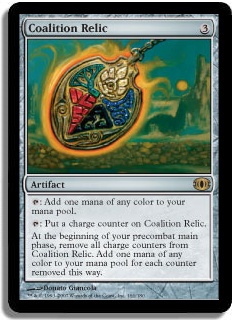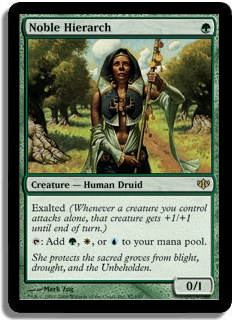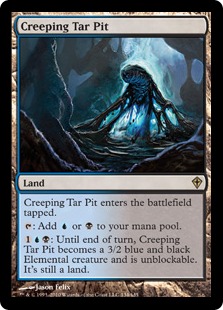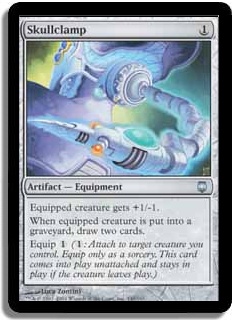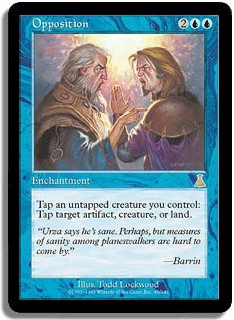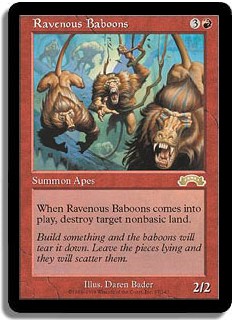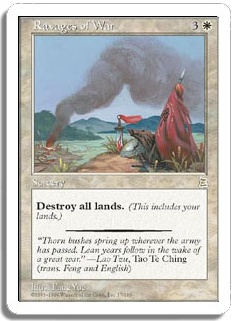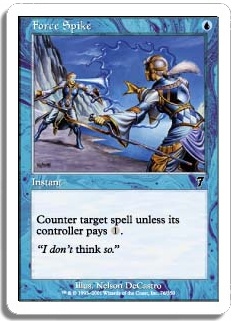When I first heard the announcement that Cube is going to be one of the formats for the Player’s Championship, I didn’t know what to think. I hadn’t really ever cubed before. I’d only done a handful of drafts in my life, usually no more than once with any particular cube, so I never really got a handle on it. So when I heard that the actual cube that we’re going to be using at the Player’s Championship was going to be on Magic Online for a week, I decided that I was going to spend that time playing as much Cube as I could. Between when it went up last week until the servers went down Tuesday night (literally—I was still playing when the server shutdown messages were sent out), I played as much Cube as I could handle, including a nine and a half hour marathon session that I streamed on Sunday. At this point, I’ve finally come to a conclusion about the format.
Cube is awesome.
In what other format can you attack with Soldiers from a Kjeldoran Outpost to trigger Windbrisk Heights, cast the Upheaval you had hidden under it, and then replay Gilded Lotus and Phyrexian Processor in the same turn? Where else am I going to get to play against Reid Duke in the finals of a queue and have our second game come down to him decking me with the Obliterate he got back with Nucklavee after using Capsize to return my Karn to my hand and prevent me from restarting the game with his Kozilek when I was down to only two cards left in my library? Cube is a format where the coolest cards from throughout Magic’s history can come together for amazing moments unlike anything else.
I certainly make no claims that my experience over the last week has made me into the world’s best cube drafter, but I certainly learned quite a bit. I’m going to share some of the lessons I took away from my experience with you.
On a side note, I wish the Magic Online Cube would stay up just a little bit longer. I had a number of friends tell me that after watching me play over the weekend they really wanted to give Cube drafting a try, only to find out that they no longer could. Similarly, I’m sure those of you watching Cube videos and reading Cube articles this week are feeling a little miffed that you can’t put what you’re learning into practice for at least another few months, unless WotC decides to bequeath us with the gift of Cube again soon. But for those of you who aren’t at all interested in Cube as a result—worry not! I’m going to share my thoughts on the first Standard tournaments with M13 as well, so don’t go anywhere!
Anyway, the cubing lessons I learned. Remember, cubes are all unique, so some of these may only apply to the Magic Online Cube and not the one you play with regularly. They also may just be completely misguided, and I’d be happy to hear your thoughts about why I’m wrong in the comments. Remember: I’m still learning too!
Mana Is King
In Cube, you’re going to have a wealth of opportunities to pick powerful cards. It’s easy to remember how dominant a card was in its particular Limited format and want to slam it first pick, first pack. When I was streaming my drafts, I had tons of people urging me to take cards like Baneslayer Angel. But Cube has more in common with Constructed formats than it does with Draft. There are tons of powerful cards, especially powerful creatures, but there are also tons of ways to deal with them.
What there isn’t a ton of is good ways to improve your mana. Here, I mean both mana fixing and mana acceleration, along with utility lands. It’s a rare cube draft that you’re scraping for playables to fill out your deck; it’s much more common that you’re lamenting the fact that all of these sweet cards you drafted are going to be incredibly hard to cast. I place a high priority on all three of mana fixers, mana accelerators, and utility lands.
Cards like Coalition Relic and Noble Hierarch that serve as both mana fixing and mana acceleration are among my favorite early picks in Cube. Creature lands like Creeping Tar Pit and Celestial Colonnade are dramatically more powerful than they were in their original Limited formats thanks to providing crucial color fixing and functional power out of your land slots. The power level of cards in Cube Draft makes it that much harder to come back from a slow start. The aggressive decks kill you that much faster, and the good control decks have proactive threats like planeswalkers to punish your stumbles.
Speaking of which…
When In Doubt, Take the Planeswalker
Remember when I said that Cube is full of ways to deal with all the powerful threats? There’s one category of cards excluded from that: planeswalkers. So many of the cards in the cube predate the existence of planeswalkers that Liliana, Garruk, and friends manage to dodge a ton of the removal effects. Not only do cards like Jokulhaups and Nevinyrral’s Disk work poorly against planeswalkers, but for the very same reason they work amazingly well alongside them. Have you ever cast Akroma’s Vengeance with multiple planeswalkers in play? Because I have, and it’s about as awesome as you might imagine.
I’ve found the best planeswalkers are those that serve dual purposes and can fit into a variety of archetypes, like Elspeth, Knight-Errant, (amazing in both control and aggressive decks), Garruk Wildspeaker (great as a threat or ramp card), and Jace, the Mind Sculptor (duh). Even the “bad” planeswalkers in the cube are still quite impressive. Both versions of Chandra can dominate games with the right support, and even poor, maligned Tibalt can be devastating in certain matchups.
Perhaps my favorite card in the entire cube to first pick (not the best, mind you—just my favorite) is Karn Liberated. Karn is a fantastic win condition for both control and ramp decks and gives you tremendous flexibility with your colors, something that is very important to keep in mind while you’re drafting. Not only that, but he’s one of the best cards to deal with opposing planeswalkers, which—as we’ve learned—are among the strongest cards you can expect to face.
Synergy Above All
A pile of individually powerful cards does not make a deck. Wrath of God may be powerful, but it certainly isn’t what your aggressive white deck is looking for. You have to remember that you’re building a deck, and just like in Constructed you’re going to want cards that work together. There are very clear archetypes in Cube, like aggro, tempo, and control, but also niche ones like Storm and Reanimator. It’s important to recognize what kind of deck you’re drafting and what sort of cards you need for that deck.
This is true of other Draft formats as well, but its importance is magnified in Cube because of how powerful the potential synergies can be. I like to pick up cards early that allow me to draft around them to maximize their power. This includes cards like Skullclamp and Opposition. If I have Skullclamp, I’m going to snatch up cards like Bitterblossom and Bloodghast as soon as I can because the effectiveness of either card is multiplied manifold by the presence of the other. Similarly, I’ve lost track of the number of decks I’ve had with both Deranged Hermit and Opposition—people played Squirrel Nest and Opposition together in Standard for a reason!
Go Big or Go Home
The Magic Online Cube in particular lends itself quite strongly toward big, powerful effects deciding games. The mana fixing in the cube isn’t quite sufficient to support true two-color aggro decks considering how many of the best aggro cards require multiple mana of a specific color, so the best aggro decks tend to be either mono-red, mono-white, or mono-black. Frequently the tools to build these decks aren’t there, so the aggro decks end up being rather anemic two-colored things that can’t quite close out the game before cards like Titans can take over.
With this in mind, it’s important to have a plan for how your deck is going to handle opposing big spells. The best single-minded aggro decks can frequently run over their opponents before they can defend themselves, but even they frequently want help disrupting the Titan parade. Land destruction effects are often the best way to do this, with cards like Avalanche Riders and Ravenous Baboons among the best options while Pillage and even Aftershock are passable tools with alternate uses. Black aggro decks tend to have more actual answers to opposing bombs, while white decks can utilize the near unblockability of shadow to sneak the final points in or just seal the game immediately with Armageddon or Ravages of War.
Mana restriction in general is a very powerful effect in the cube, and cards like Force Spike and Mana Tithe are surprisingly good—as are all cheap counterspells since stopping your opponent’s big play can be backbreaking. The previously mentioned, Opposition is one of my favorite cards for a tempo blue deck (generally U/G) to keep an opponent pinned down, while Tangle Wire can be used to press an advantage once you have a few creatures in play.
Be Flexible
Again, a lesson that applies to all Draft formats, but one that is especially applicable to Cube. Don’t just pick a powerful colored spell and then keep drafting cards to support it. This isn’t Avacyn Restored Draft—you’re not going to come up short of playables if you keep your options open. I like drafting lands and artifact mana early, along with cards are useful in multiple archetypes, because if I open one of the top tier planeswalkers in pack two, I want to be able to take it. Similarly, cards like Jitte and the Swords are solid early picks because they can effectively go into so many different decks. Though I think many of the Swords are highly overrated, especially since I rarely want to be aggressive in the Magic Online Cube.
Anyway, that’s what I’ve learned. Hopefully it’s enough to carry me through the Cube rounds at the Player Championship! As I said before, I’m open to feedback on any and all of my conclusions, so please do help me out. If you want to check out my cube drafts, I recorded one for SCG this week, and you can find many others (including my nearly ten-hour Cube marathon) in my archives at http://www.twitch.tv/bmkibler.
Standard with M13
As for Standard with M13, I was pretty stoked to see Caleb Durward take down the SCG Standard Open in St. Louis with a deck very reminiscent of my own Naya Pod deck. He went with a heavier commitment to Birthing Pod itself, chaining all the way up to Elesh Norn, and abandoned maindeck removal altogether save a single Bonfire of the Damned. If the field continues to look as green as it did this first week, I wholeheartedly agree with his changes; my own list was built for a sea of Delver, and that doesn’t seem to be what the post-M13 world looks like right now.
The card that I really like out of his list is Elvish Visionary, which I hadn’t previously considered but now that I think about it seems great. I hadn’t been terribly happy with Strangleroot Geist since Blade Splicer started to appear even in Delver lists, but I didn’t feel like there were other good options for a good two-drop to hang out with Thalia. Elvish Visionary isn’t the same kind of beatdown artist as the old Geist, but it is easier on the mana (important with four Cavern of Souls in our deck) and provides substantially more value on a board cluttered with Golem tokens.
I’ll have to do some testing of my own to decide if I like the full Pod chain into Elesh Norn better than doubling down on Township effects with Mikaeus for the mirror, but in the meantime I would highly recommend Caleb’s list if you’re looking to play Naya and your local metagame has more green decks than Delvers. I still think the lighter touch with Pod is better at handling Insectile Aberrations, but it remains to be seen if we’ve wrested ourselves free of The Fly’s creepy grip on Standard.
This weekend I’ll be at GP Columbus playing Modern, so I’ll report back next week with my thoughts on that format—any guesses as to what I might be playing? If you’re there, feel free to say hi; I always enjoy meeting my readers!
One more thing before I go! This week we finally announced the big project we’ve been working on for a while now, which is a digital TCG called SolForge. I can’t share too many details with you just yet, but since you’re reading this right now, I’m pretty sure it’s the kind of thing you’d enjoy. We’re going to have a lot more news coming out about the game in the next few weeks, with a major announcement coming on August 1st. In the meantime, check us out on Facebook here and follow us on Twitter at www.twitter.com/solforgegame to stay up to date! This is by far the biggest, most exciting project I’ve ever been a part of, and I’m incredibly stoked that I’m finally able to start telling the world about it.
Until next time,
bmk

